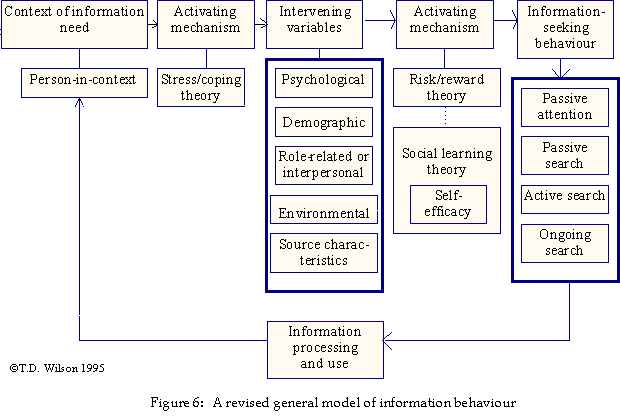
This review shows that Wilson's (1981)
model needs to be expanded to provide a more effective general framework
for the consideration of information-seeking behaviour. In particular,
we see a need to include a stage between what we shall call the person-in-context
and the decision to seek information. This is the point which Dervin
(1983) labels the gap between situation and use.
We propose to 'fill the gap' by inserting the concept of activating
mechanism, using the stress/coping model as an example of a
theoretical approach to such a mechanism, allowing, however, for sources
of motivation other than stress to exist.
A further need is to elaborate the concept of intervening variables
or barriers, to specify the fact that characteristics of the
information source may constitute a barrier, either to information-seeking
behaviour or to information processing, and that personal variables
may be either psychological or demographic.
Research also suggests the need for a further intermediate stage (or
activating mechanism) between the determination of need and the initiation
of action to satisfy the need. Here we propose the risk/reward theory,
social learning theory and the concept of self-efficacy,
as intervening concepts. Given the relationship of self-efficacy to coping,
it is debatable whether the concept should appear here or as part of the
stress/coping element but, given its relationship to social learning
theory, the location shown seems at least equally appropriate.
Wilson's framework (and Ellis's elaboration of the stages of information-seeking
behaviour) also deal only with the active search for information
and the framework needs to be expanded to include other modes of information
seeking, which may have different characteristics. This report draws attention
to other analyses of the search process and room exists for further research
on the processes that may be peculiar to the other search modes.
Finally, the model needs extension to include information processing
and information use, which are the stages beyond information-seeking
and which provide the link back to the need-arousing situation of the person-in-context.
Figure 6 is, thus, an expanded version of Wilson's
(1981) model, which takes the findings of this review into account.
Expanded in this way, the model can be taken to apply to information
behaviour more generally, rather than solely to information-seeking
behaviour

Although a great deal of research has been reviewed to bring the model
to its present state, time has not allowed for the effective incorporation
of the findings of all the research reviewed. For example, some work puts
a great deal of emphasis on other aspects of the person, or the situation,
or, in the case of mass media in particular, on characteristics of the
information sources not discussed above. Also, although the situation in
which the initial need for information arises has occasioned the investigation
of a number of variables in various studies, the situation within which
the information is found and processed appears to have been given less
analysis and, perhaps particularly in respect of the role of computers
in information-seeking, may be of some significance.
However, we believe that, in spite of the omissions, the ideas presented throughout this review offer the information science researcher a great deal to think about. With certain exceptions, much of the work reported here has been ignored by information scientists and we believe that there are analytical concepts, models and theories that need to be absorbed into information science as a matter of urgency.